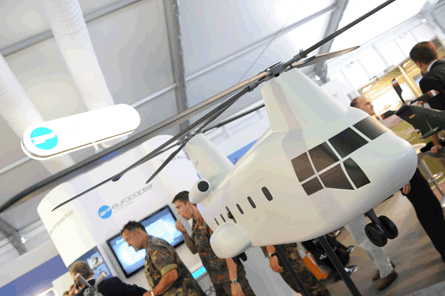Eurocopter's proposed future Heavy Transport Helicopter (HTH) design has changed dramatically, thanks to the company's fresh co-operation with US manufacturer Boeing.
On show in model form at Eurocopter's stand in the Heli Centre (hall 1, stand 130), the HTH now shows more than a passing resemblance to Boeing's iconic CH-47 Chinook, but with a massive 33t maximum take-off weight.
The aircraft's tandem four-bladed main rotors have a span of 19.5m (64ft) and the helicopter would be capable of carrying up to 56 troops in addition to its three-person crew, Eurocopter says. The concept has a proposed 167kt (310km/h) top speed, and would cruise at around 148kt to an altitude of around 23,000ft.
 |
|---|
© Billypix |
Eurocopter says the concept has a projected range of 300km (162nm) with its maximum 13t payload, with this increasing to 1,000km at 8t. In-flight refuelling would stretch its range to up to 5,000km, it adds.
Acting on behalf of the French and German governments, the European Defence Agency (EDA) has previously identified a requirement for a new transport helicopter capable of lifting 13t of equipment and supplies.
The HTH design has now moved beyond the concept stage, although no formal acquisition programme has been established by potential buyers. And Eurocopter’s relationship with Boeing marks a departure from the USA’s initial reluctance to work with European industry when the system was first touted in 2004.
“What is quite logical is that two global players are sitting together and sharing their strengths and knowledge,” says Hans Weber, Eurocopter’s vice-president of the HTH programme. “We have a logical structure of workshare driven by competencies, and not by politics. What you see is the outcome so far.”
Weber says “the pre-design is very mature, and meets the requirements set by the NATO staff targets.” The companies have been exchanging proposed solutions with the organisation for the last one to two years, and “so far we’ve got very positive feedback,” he adds.
The intention is for Boeing and Eurocopter to each perform 50% of a future project, using off-the-shelf technologies wherever possible. “This helicopter should not be used as a technology platform, but use state of the art technologies which already exist,” Weber says. “This makes it cheaper, and easier.”
For example, several candidate engines already exist which could power the design, he notes.
The EDA hosted a half-day aerial capabilities seminar at the show on Tuesday, with discussion topics having included industrial collaboration, air transport and unmanned air vehicles. "Europe's military aerospace industry is unlikely to be sustained without transformational action and new ways of business," the agency says.
Source: Flight Daily News























